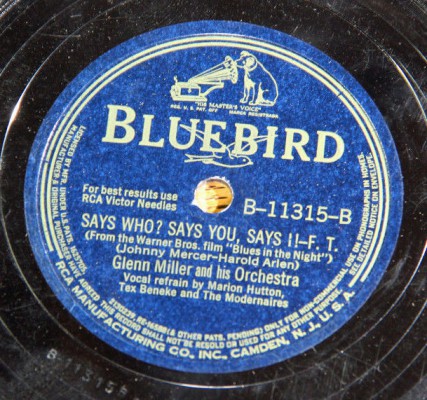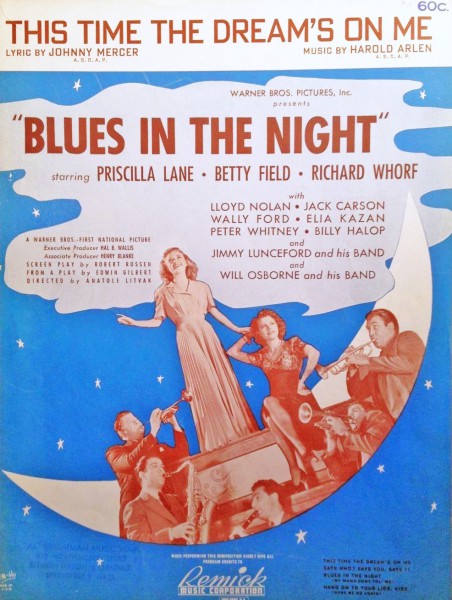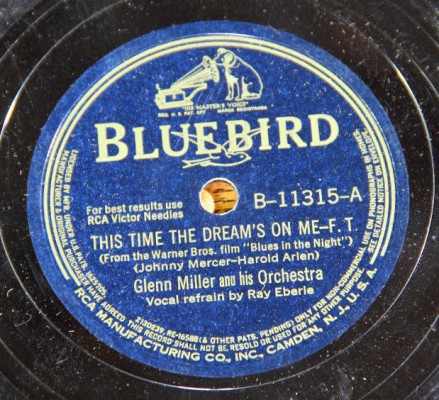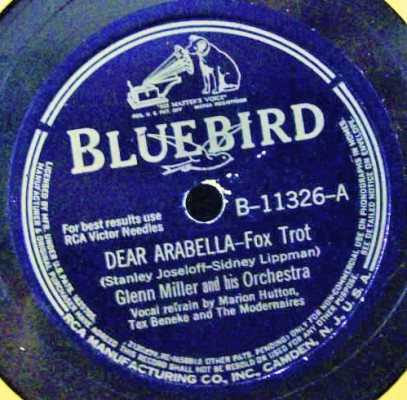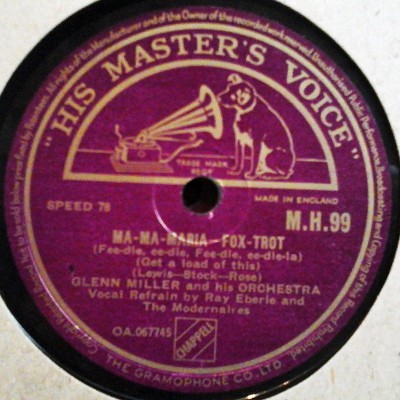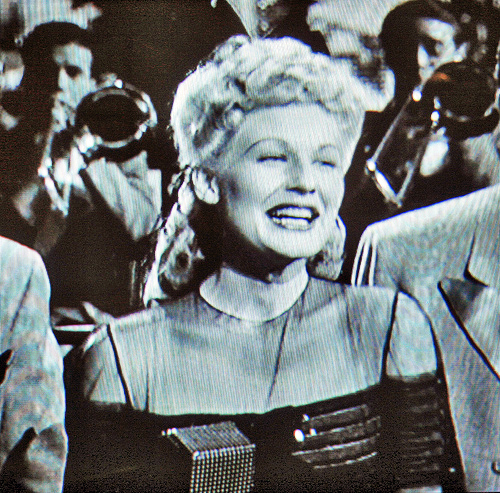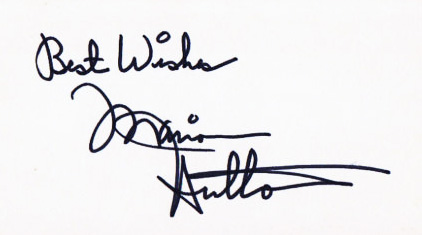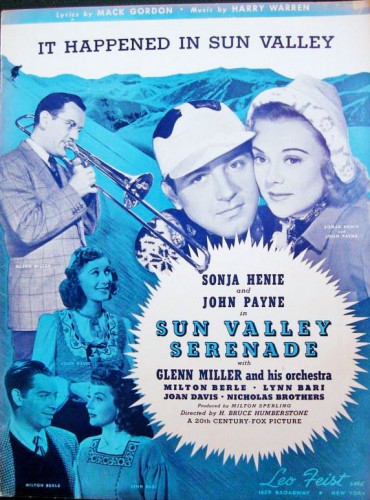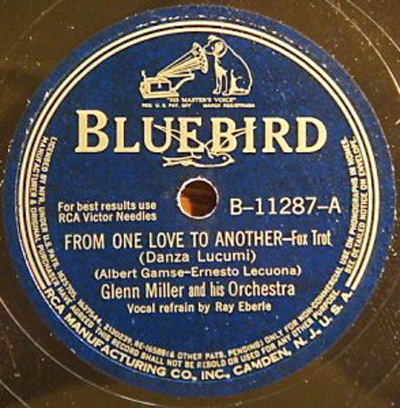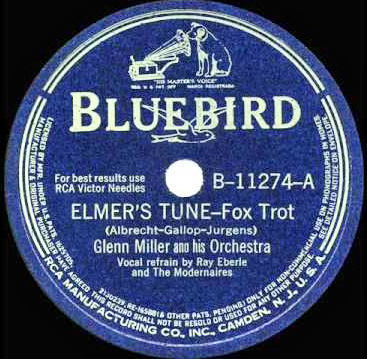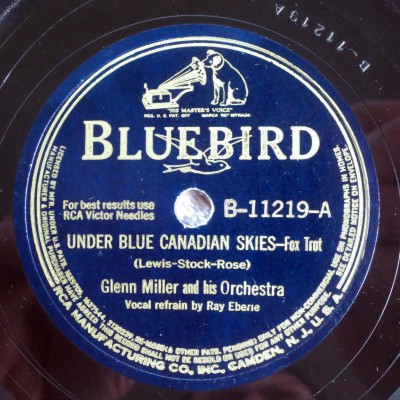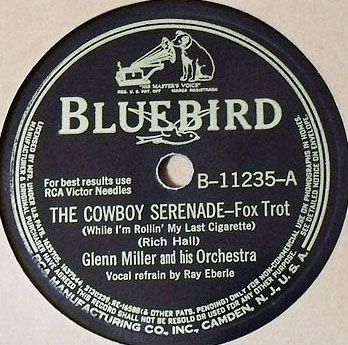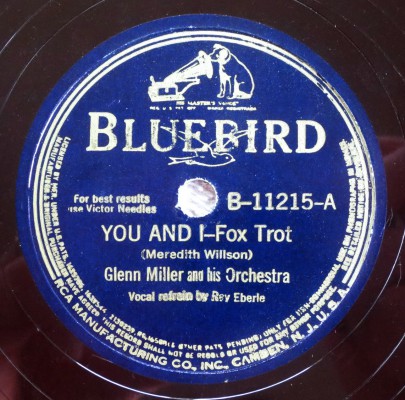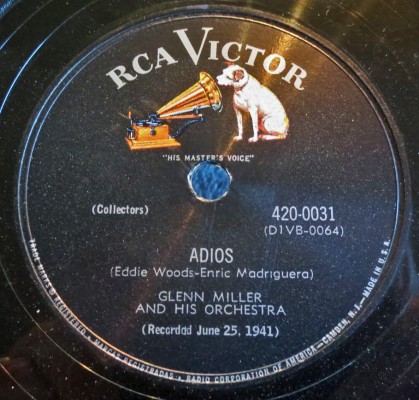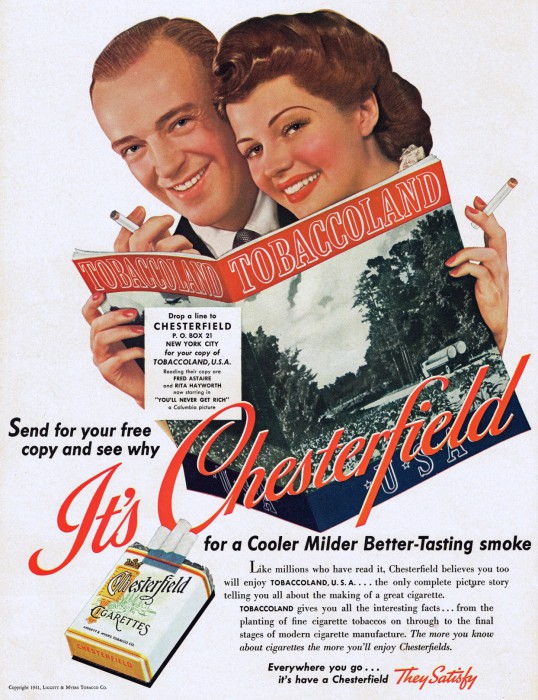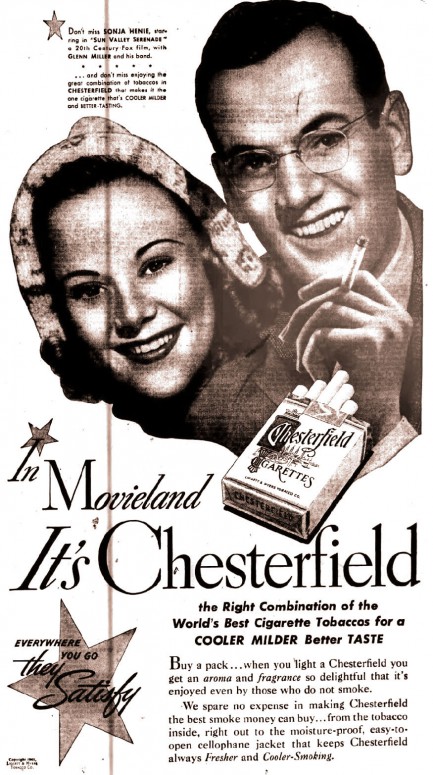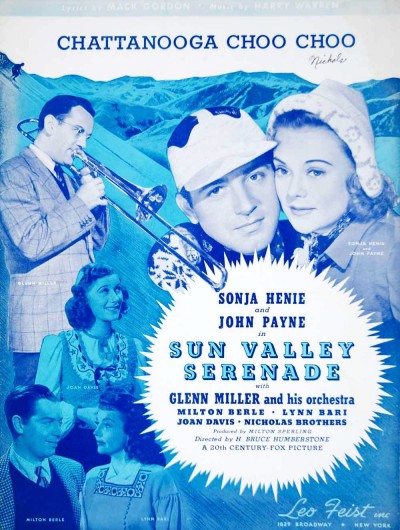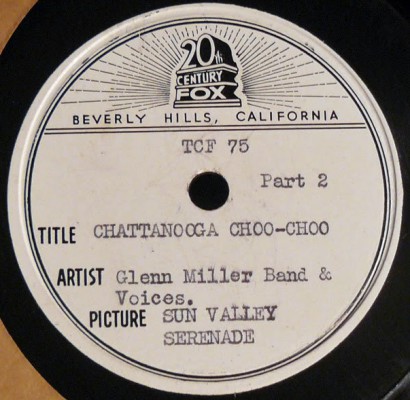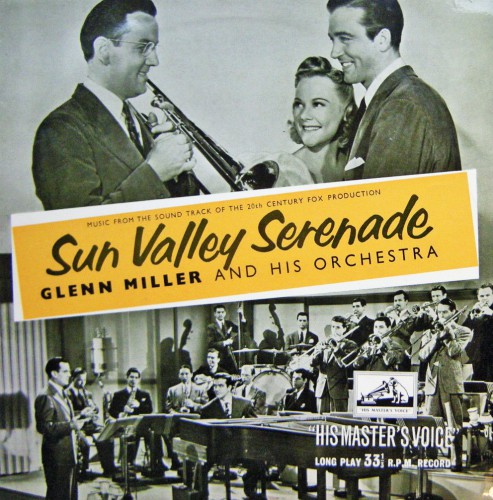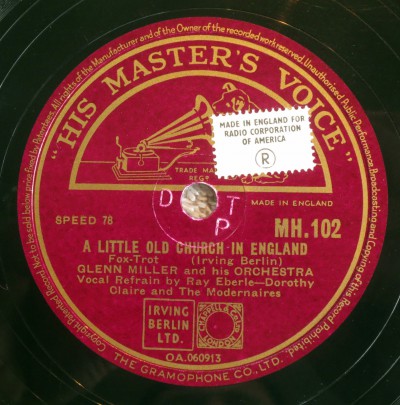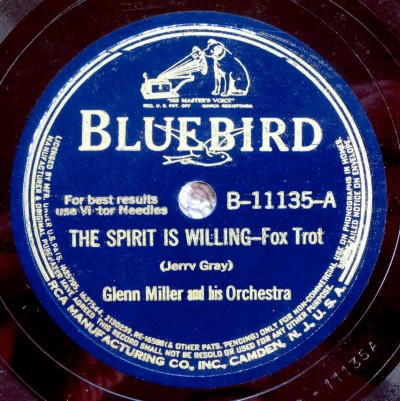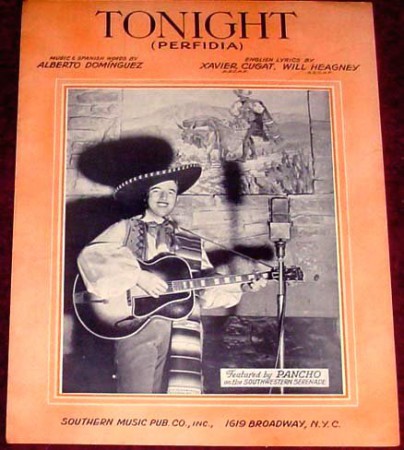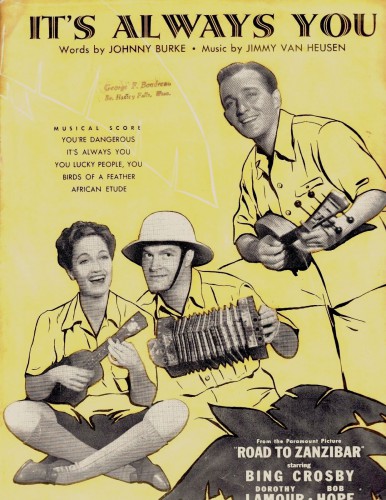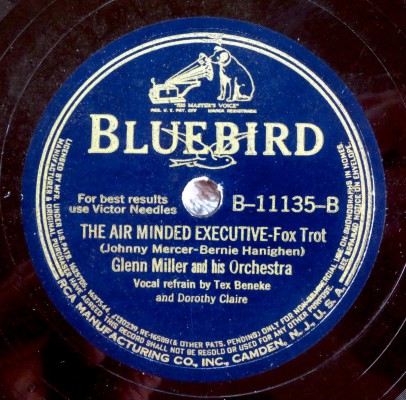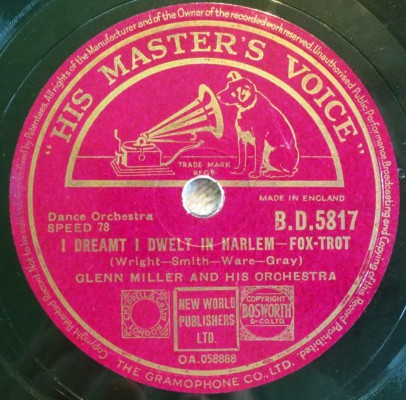Mickey McMickle, Johnny Best, Alec Fila, Billy May (tp); Glenn Miller, Paul Tanner, Jimmy Priddy, Frank D’Annolfo (tb); Hal McIntyre, Wilbur Schwartz, Ernie Caceres, Tex Beneke, Al Klink (reeds); Chummy MacGregor (p); Bobby Hackett (g & cornet); Doc Goldberg (b); Maurice Purtill (d); Marion Hutton, Ray Eberle, Tex Beneke, The Modernaires (vcl); Bill Finegan, Jerry Gray, Billy May (arr).
RCA Victor Studios, New York – September 3, 1941, 9:00 AM-3:00 PM
067741-1 Says Who? Says You, Says I! (MH, TB & M vcl) Bluebird 11315-B
067742-1 Orange Blossom Lane (RE vcl, JG arr) Bluebird 11326-B
067743-1 Dear Arabella (MH, TB & M vcl, JG arr) Bluebird 11326-A
067744-1 The Man in the Moon (RE vcl, JG arr) Bluebird 11299-B
067745-1 Ma-Ma Maria (RE & M vcl, BF arr) Bluebird 11299- A
067746-1 This Time the Dream’s on Me (RE vcl, BF arr) Bluebird 11315-A
Four days after their August 11th RCA Bluebird session, pert and pretty Marion Hutton returned to the Glenn Miller band, having given birth to a son in late May. Paula Kelly shifted to Artie Shaw’s band (but returned to permanently front the Modernaires as a solo act in 1943). Marion sings in a much more assured, mature manner during this second Miller stint, but for some reason, rarely sang solos anymore and was usually paired with the Modernaires.
This session featured two fine Harold Arlen-Johnny Mercer songs from the film, Blues in the Night, which was a genre-crossing film-noirish semi-musical about an itinerant jazz band. Originally titled New Orleans Nights, even though most of the film was set in New Jersey, the early success of one of the featured numbers led to the title change. Actually, none of the tunes were fully featured in the movie, which interrupted all the music with dialogue and artsy montages, a specialty of director Anatole Litvak. Even BLUES IN THE NIGHT, which eventually became a pop standard, was tossed off in a montage with a black chorus of jailed prisoners.
Jimmie Lunceford’s fabulous orchestra was nearly wasted in a short bit st at a roadhouse and the Will Osborne band plays a caricature of themselves in a nightclub scene, which is supposed to show the lead character’s decline by being forced to play piano in such a soggy group.
Glenn featured a superb Billy May arrangement of BLUES IN THE NIGHT on the air, but didn’t record it because Charlie Barnet got it for Bluebird (as did Dinah Shore). Every label saw the potential in the song and produced widely varying versions – few songs of the era were covered so thoroughly on wax! Artie Shaw performed it for Victor, in a superb version featuring Hot Lips Page at a somewhat rushed tempo to fit the whole chart in (too bad the label didn’t spring for a 12-inch disc).
Tommy Dorsey also cut it with Jo Stafford on Victor, but held it back (until 1968!) so as not to cut into Artie Shaw’s sales. Benny Goodman featured Peggy Lee on a groovy Sextet record for Okeh. Cab Calloway’s full band also did an Okeh disc. Harry James brought in the lush strings on Columbia. Woody Herman featured it on Decca, as did Jimmie Lunceford on a two-sided 78 that superbly expanded the brief performance his band did in the original film.
Glenn did cut the film’s hit ballad, THIS TIME THE DREAM’S ON ME and the novelty SAYS WHO? SAYS YOU, SAYS I!, full of Merceresque wordplay. SAYS WHO? was deliberately trashed on screen in a cornball arrangement played by the Osborne band, with brash Mabel Todd braying with an intrusive vocal group (who also tap-dances on the piano). Glenn’s disc is much more subdued, almost too much so. Marion, Tex and the Mods have a fine time with the witty lyrics, but the tempo begins to sag a bit toward the end. A sparkier beat (or a bit more rehearsal) might have helped. Unfortunately, this is the only Miller performance of the song, as he never programmed it on the air.
Bobby Hackett is featured on the opening chorus of THIS TIME THE DREAM’S ON ME, sounding a bit tentative as his horn dances around the reeds. Hackett is more expansive and assured on a later aircheck of the song. Ray Eberle supplies a nice vocal, supported by Bill Finegan’s lovely arrangement. During this period, Ray was singing quite well, with only the occasional bit of sloppy diction to mar his efforts. Six-hour marathon record sessions, like this one, can be hard on the voice!
From high to low – ORANGE BLOSSOM LANE is a very forgettable number, written by classy songwriters Peter DeRose (DEEP PURPLE and ON A LITTLE STREET IN SINGAPORE) with lyrics by MOONLIGHT SERENADE’s Mitchell Parish. Newspaper columnist Nick Kenny’s name is also on the song. As mentioned in the September 1939 writeup of LAST NIGHT, many singers and bandleaders performed Kenny’s songs in order to get favorable press coverage. Glenn wasn’t one of them, as he only played two or three Kenny songs with his band. Why ORANGE BLOSSOM LANE was chosen for recording is a puzzle. Jerry Gray set the number in a fine arrangement, with brief solos by Hal McIntyre, Johnny Best, Glenn and Tex, helping Ray Eberle along. The result is still a dreary picture in a lovely frame.
DEAR ARABELLA is a perkier novelty, from the pre-wartime sub-genre of unfaithful soldiers’ sweethearts. ARABELLA is pretty blatant, advising her Army sweetie that she is cheating on him with other guys, but keeping his picture around to look at while doing so! THREE LITTLE SISTERS is a similar song, with the gals cheating on their men with members of all the Armed Services! December 7th put an end to these ditties, as the last thing soldiers wanted to hear was that their ladies were having a grand old time while they were gone. Soon DON’T SIT UNDER THE APPLE TREE would set a new template, with girlfriends promising to be faithful forever (where has that phrase been heard before?).
In spite of its salacious message, DEAR ARABELLA became a popular Miller number, played often on the air through April 1942. Marion does her best Mae West imitation, with Tex and the Mods chiming in. Jerry Gray’s enjoyable chart has Billy May supplying wry comments to the plight of Arabella’s “Private Johnny.” Written by Sid Lippman, author of I’M THRILLED, whose big hits would come later with “A” YOU’RE ADORABLE and TOO YOUNG.
Another song with “outside” connections is THE MAN IN THE MOON. Apparently written by Glenn’s own Jerry Gray, it became the theme melody of WMCA New York radio DJ Jerry Lawrence, who got his name on the number. Lawrence would later become a TV host and announcer on shows like Truth or Consequences. Co-composer John Benson Brooks would soon write JUST AS THOUGH YOU WERE HERE for Tommy Dorsey and later such diverse tunes as WHERE FLAMINGOS FLY and YOU CAME A LONG WAY FROM ST. LOUIS (a big hit for future Miller cohort Ray McKinley).
THE MAN IN THE MOON happens to be a great song and naturally, Jerry Gray arranged it for the Miller band. The reeds sing out rather plaintively in the first chorus and Ray Eberle puts real feeling into the lyrics. Another neglected Miller thriller!
Can’t say the same about MA-MA-MARIA (FEE-DLE, EE-DLE-LEE, FEE-DLE-EE-DLE-LA), which is a rancid slice of Neapolitan cheese and one of the most painful songs ever immortalized by Glenn. It was written by the same guys, Vincent Rose, Larry Stock and Al Lewis, who gave us BLUEBERRY HILL and UNDER BLUE CANADIAN SKIES. They should have had their ASCAP affilations yanked over this one. If the inane lyrics don’t get you, the “Fee-dle-ee-dle-las” certainly will. And Ray and the Mods don’t stop, repeating and repeating the phrase until the last note, like a dentlst’s drill. File this one under “Fee-dle-ee-dle-Blah.”
Glenn and the boys (and girl) took off for a week in Boston right after this record date, then over to Albany and Schenectady. A week in Philadelphia and then another week in Pittsburgh followed, with the band returning to New York to open another winter season at the Cafe Rouge on October 5. Two weeks after that, they finally paid a return visit to RCA on October 20th to record, as Glenn might say, “some more swell songs.”



